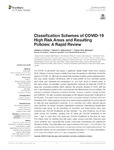2022-02-25Zeitschriftenartikel
Classification Schemes of COVID-19 High Risk Areas and Resulting Policies: A Rapid Review
Uthman, Olalekan A.
Adetokunboh, Olatunji O.
Wiysonge, Charles Shey
Al-Awlaqi, Sameh
Hanefeld, Johanna
El Bcheraoui, Charbel
The COVID-19 pandemic has posed a significant global health threat since January 2020. Policies to reduce human mobility have been recognized to effectively control the spread of COVID-19; although the relationship between mobility, policy implementation, and virus spread remains contentious, with no clear pattern for how countries classify each other, and determine the destinations to- and from which to restrict travel. In this rapid review, we identified country classification schemes for high-risk COVID-19 areas and associated policies which mirrored the dynamic situation in 2020, with the aim of identifying any patterns that could indicate the effectiveness of such policies. We searched academic databases, including PubMed, Scopus, medRxiv, Google Scholar, and EMBASE. We also consulted web pages of the relevant government institutions in all countries. This rapid review's searches were conducted between October 2020 and December 2021. Web scraping of policy documents yielded additional 43 country reports on high-risk area classification schemes. In 43 countries from which relevant reports were identified, six issued domestic classification schemes. International classification schemes were issued by the remaining 38 countries, and these mainly used case incidence per 100,000 inhabitants as key indicator. The case incidence cut-off also varied across the countries, ranging from 20 cases per 100,000 inhabitants in the past 7 days to more than 100 cases per 100,000 inhabitants in the past 28 days. The criteria used for defining high-risk areas varied across countries, including case count, positivity rate, composite risk scores, community transmission and satisfactory laboratory testing. Countries either used case incidence in the past 7, 14 or 28 days. The resulting policies included restrictions on internal movement and international travel. The quarantine policies can be summarized into three categories: (1) 14 days self-isolation, (2) 10 days self-isolation and (3) 14 days compulsory isolation.
Dateien zu dieser Publikation

